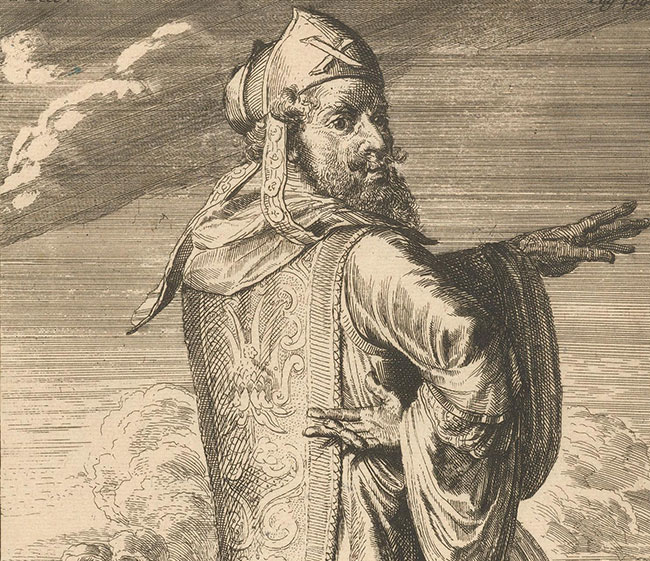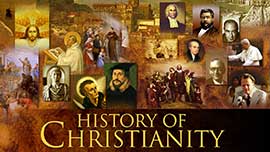A FEUD BETWEEN NESTORIUS AND CYRIL SPLIT THE CHURCH

[Nestorius as imagined by Romeyn de Hooghe —History of the Churches and Heretics...until the year Our Lord 1688 / public domain, Wikipedia File:Nestorius Hooghe 1688.png]
IN 428 the see of Constantinople became empty through the death of its bishop. Church and secular powers were unable to agree on a successor. They appealed to Emperor Theodosius II to make the decision and he chose Nestorius, a monk well-known for his preaching. Nestorius was consecrated bishop of Constantinople on this day 10 April 428. A contentious figure, he held the position only a few years. Declared a heretic, he was deposed, and ultimately banished to the Egyptian desert.
The visible reason for his downfall was that Nestorius was reluctant to accept the popular designation of Mary as “Mother of God.” He pointed out that the apostles and early church fathers never employed the term. Jesus had a human nature, Nestorius said, as well as his God nature. Jesus’s physical body carried out his human behaviors and actions, and suffered those things that humans suffer, including death. To say Mary was Mother of God was to say God had once been a few hours old—whereas God exists from eternity past and cannot die. “God is not a baby two or three months old,” he argued.
To protect Christ’s divinity, Nestorius argued that the Godhead must have joined with the human body rather as if a man entered a tent or put on clothes. Nestorius remained fully convinced that Jesus Christ has two natures, the human and the divine (as all orthodox Christians believe), but he spoke of the Son of Mary and the Son of God in a manner that led some critics to think he was speaking of two sons, two persons. And his insistence on the importance of the manhood of Christ led others to suspect him of Arianism. Arians taught that Christ was a created being, not truly divine.
Opponents had some justification for suspicion. Arians had controlled the see of Constantinople for more than forty years during the fourth century. Aggravating the situation was Nestorius’s abrasive personality and his failure to give a thoughtful explanation of his position to Rome when the pope asked. Alexandria’s patriarch, Cyril, was a despotic man who had ascended to his see amid bloodshed and cared little for fair play as long as his theology triumphed. Rome and Alexandria already resented the influence of the “upstart” see at Constantinople and worked in collusion to take Nestorius down.
Nestorius and Cyril employed terms differently; therefore each thought the other was making heretical statements when in actuality their positions were similar. Cyril issued twelve anathemas against Nestorius. Nestorius anathemized him back. With no reconciliation in sight, Theodosius summoned a council to Ephesus to settle the matter and appointed John of Antioch to head it. Cyril arrived first and took control. He and his allies deposed Nestorius before the latter’s Syrian supporters could reach the site. When John arrived, he held a rival council.
Nestorius always claimed Cyril misrepresented his statements or took them out of context. In exile, he wrote a lengthy defense that was rediscovered in the nineteenth century. Theologians who have studied this defense and Nestorius’s few surviving sermons say that his opinions don’t seem to have been heretical. Nestorius himself accepted the conclusions of the Council of Chalcedon, held in 451, which, among other things, addressed concerns about Christ’s being,
We . . . confess our Lord Jesus Christ one and the same Son, at once complete in manhood, truly God and truly man, consisting of a reasonable soul and body; of one substance with the Father as regards his Godhead, of one substance with us as regards his manhood ...
The squabble had long-lasting effects. Driven out, Nestorius’s followers formed their own widespread church. For close to a thousand years this movement flourished in Persia, Arabia, India, Tibet, Malabar, Turkostan, Cyprus, and even for a time in China. Nestorians survive to this day, although they never recovered from the Mongol invasions and from the spread of Islam.
—Dan Graves
----- ----- -----
For more about early Christianity, watch History of Christianity at RedeemTV
History of Christianity can be purchased at Vision Video







